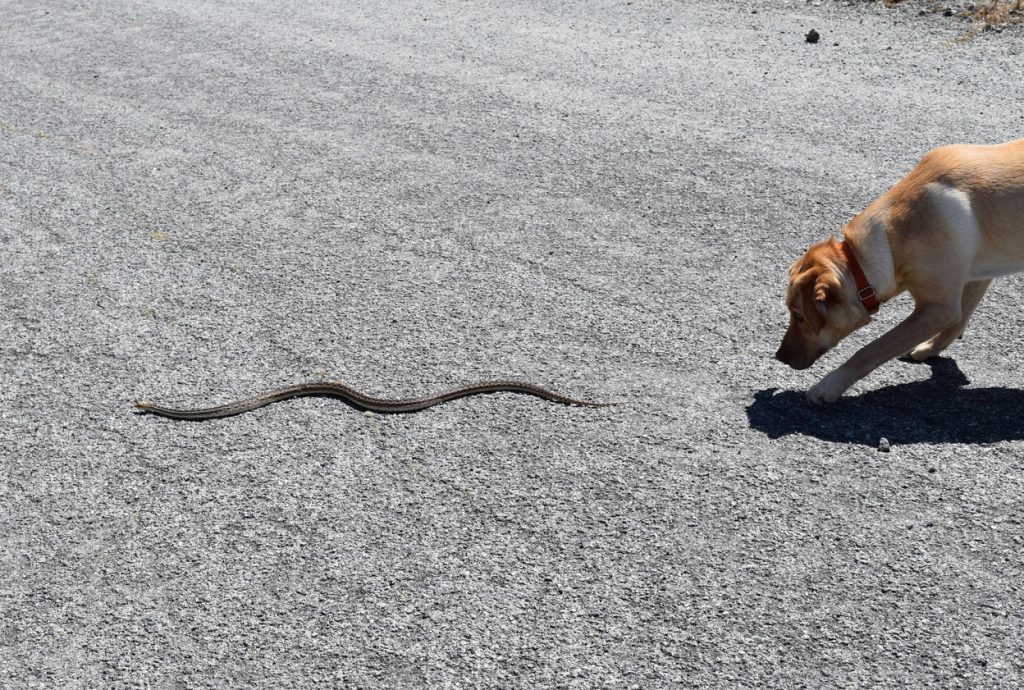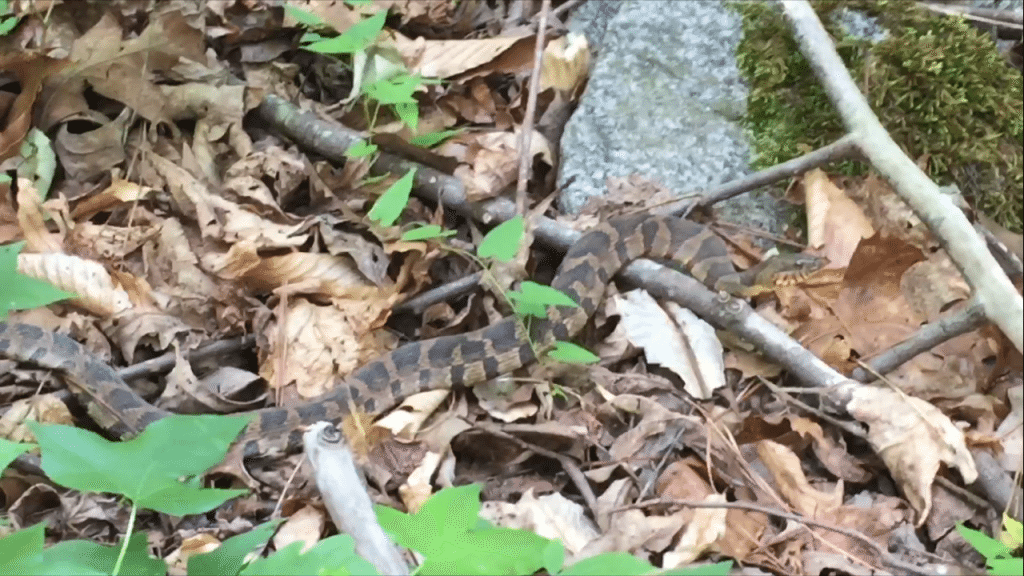
It’s summer time! As the weather heats up, it’s a good idea to keep an eye out for snakes – for the safety of both you and your dog. According to PetMD approximately, 8,000 people are bitten by venomous snakes annually. The estimated number of dogs and cats is much higher. Approximately 300,000 dogs and cats are bitten annually by snakes. Between April and October are the months when most snake bites take place. So now is a good time to learn about snake bite prevention and how to keep your dog safe.
Snakes Bites On The Rise
Some areas in the U.S. are experiencing a rise in snake bites. The Atlanta Journal Consitution reported that the North Georgia Veterinary Specialists in Buford GA are experiencing a 25 percent increase in snake bites. Other places reporting a rise includes Western North Carolina and Las Vegas.
My Dog’s Close Call With A Snake
I was jogging on a wooded trail with my dogs this week when all of a sudden I spotted a 3-foot snake slithering across the trail. My labrador, named Rio, was off leash. He was running out in front of me and unknowingly, galloping directly toward the snake. I immediately yelled, “This way! This way!”. This is my cue to Rio, that I’m changing directions. The added excitement in my voice made him abruptly stop. He turned to look at me and I quickly started to run backward. As he started to run back in my direction, I then gave the come “touch” command. With the touch command, I hold my arm down by my side with the palm of my hand open and facing the dog. I want him to touch my hand with his nose so that with my other hand I can reach around and grab his collar. Otherwise, he may just go around me and keep running but I wanted to get control of this situation as fast as possible.

Luckily, we have been working a lot on recall and this helped us avoid a potentially dangerous situation with a snake. Here are some additional safety precautions and tips to help your dog avoid being bitten by a snake.
12 Snake Bite Prevention Tips For Dog Owners
1. Avoid letting your dog explore or play in areas overgrown with bushes, tall grass, and rocks. These are ideal places where snakes like to hide and hunt.
2. Keep your yard neat and uncluttered so you don’t get any unwanted guests. Keep ivy and monkey grass cut and trimmed.
3. When hiking or walking in an area where snakes are prevalent, keep your dog on a leash. This will allow you to keep control over your dog at all times. By keeping your dog on a leash, you can keep him on the trail where it’s easier to spot and avoid a snake encounter.
4. Be extra vigilant after heavy rains. You have an increased chance of running into a snake 5 to 6 days after heavy rains, according to board-certified Toxicologist, Dr. Spencer Greene. After the water starts to recede from heavy rain storms, the snakes come out of hiding. As they head back to their normal habitat is when you are at an increased risk of an encounter.
5. Be extra vigilant when walking your dog at night. Snakes may be more active at night and harder to spot. For example, copperheads and rattlesnakes are nocturnal during the summer months.
6. Use bird feeders only in the winter time. Avoid using bird feeders in the summer time because they can draw in rodents and other small animals which are food sources for snakes.
7. If you see a snake – keep your distance. And here’s why!
- A snake’s striking distance is about 1/2 their body length – so a four-foot snake could strike you or your dog from 2 feet away.
- A snake’s strike is super, ultra fast. According to a study reported by the Smithsonian, “a snake can lunge forward about half a foot in only 70 milliseconds”. Literally, that’s faster than a blink of an eye – which is clocked at 240 milliseconds.
8. Even if you think a snake is dead, do not let your dog touch the snake. Reflex actions can still cause a dead snake to bite. They are still extremely dangerous and still carry venom. A snake can bite up to 90 minutes after it dies – even with a severed head.
9. No-Shock Snake Aversion Training. This type of training teaches your dog how to detect a snake by sight, sound (rattle), and smell – and then to avoid the snake. I recommend NO-Shock training methods ONLY. But remember, even with snake aversion training there is no guarantee that your dog will never be bitten. Dogs are sometimes bitten when they accidentally and unknowingly surprise a snake.
10. Basic obedience dog training. Even with some basic dog training you can help your dog avoid dangerous snake encounters. For example:
- Recall – teaching your dog to come to you will be valuable in so many situations – not just with avoiding snake bites. Practice this one over and over and over.
- Heel – This would allow you to walk/hike/jog with your dog by your side without the need for a leash.
- Leave It – If your dog sees a snake he is likely to be curious. Teach your dog the “Leave it” cue so you can prevent him from getting too close.
- Stay or Freeze in place – Teach your dog to stay or to freeze in place so that you can approach your dog and safely remove/escort him away from the snake.
11. Snake bite vaccination. This doesn’t actually prevent your dog from being bitten but it is a preventive measure. There is a lot of debate around this vaccine so discuss the pros and cons with your veterinarian. The vaccine is only for protection against the Western Diamondback rattlesnake and does not protect against any other venomous snake. Additionally, the vaccine does not make your dog immune to the snake bite – you still need to seek immediate emergency medical care for your dog if he is bitten.
12. Swimming precautions. Don’t let your dog swim in lakes or rivers where the banks are dense and overgrown with tall grass and bushes. Avoid rocky areas and stay away from fallen trees. You want the area where your dog enters the water to be open and clear.
Please keep in mind that even if you take all of these precautions, there is no guarantee that your dog will never be bitten. Snakes are not evil animals but they are to be respected. Their first line of defense is to flee from danger. They only bite when they feel threatened and are cornered. Up to 80% of snake bites are because someone was trying to capture or kill the snake. So the simplest snake bite prevention tip is to leave them alone and just walk away.









